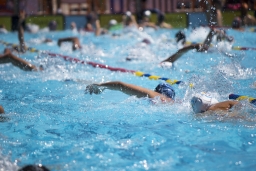The Role of Motives in the Transition from Youth Swimming to Masters Swimming
Wednesday, March 27, 2019 - 07:00

Masters sport is a great way for adults to have fun and stay active. Dionigi (2015) identified three categories of masters athletes, based on their pathway into masters sport. “Late bloomers” are those who don’t start participating in sport until adulthood. “Continuers” are those who began their sport involvement as youth and never stopped. Finally, “rekindlers” are those who participated in sports when they were young, took a break, and then picked them up again later on in life.
Research suggests that many masters swimmers fall into this rekindler category. We surveyed over 200 Canadian masters swimmers who had previous youth swimming experience and found they took an average of 13 years off between leaving youth swimming and returning to the sport as masters athletes. This long gap in swimming participation might be partially explained by external obligations, such as school, family, career, or finances. However, we wondered if the nature of their youth swimming experiences might also contribute to this gap.
We decided to explore how youth sport experiences might shape subsequent participation in masters sport, from a motivational perspective (Larson, McHugh, Young, & Rodgers, 2019). Our study involved interviews with twenty masters swimmers, all of whom had prior competitive swimming experience as youth. About half of these swimmers (the continuers) transitioned directly from youth swimming into masters swimming, without taking a break. The rest (the rekindlers) took an average of 16 years off between ending their youth swimming participation and returning to the sport as adults.
Retrospective interviews revealed that these two groups of swimmers shared some common youth swimming experiences, including high training volume and the realization of their limits in terms of performance. However, there were other aspects of their training context that influenced their perceptions of these experiences, and subsequently affected their motivation for swimming.
For example, high training volume alone wasn’t usually enough to turn people off swimming, but when it occurred alongside performance plateaus, an inability to pursue other activities, and poor relationships with coaches or teammates, this led rekindlers to seek time away from the pool. By contrast, continuers who reported high training volumes also spoke of strong relationships with coaches and teammates that made the training more bearable—even enjoyable.
Although every swimmer reached a point in their youth swimming career where they realized that they weren’t going to make it to the Olympics, their response to this realization depended on their motives for swimming. The rekindlers, who were focused on performance, started to feel that the training wasn’t worth it any more, and the costs outweighed the benefits. They discontinued their swimming participation. However, the continuers had identified multiple benefits—unrelated to performance—that they wanted to continue accumulating through masters swimming participation. These included things like enjoyment, fitness, and social aspects.
There are three practical implications of this study for coaches and parents who want to encourage continued swimming participation from youth through adulthood:
- Allow swimmers opportunities to participate in activities outside of swimming. If they are forced to choose between equally attractive activities, they may drop swimming. Even if they stay, there can be resentment and decreased enjoyment that lead to dropout later on.
- Nurture strong relationships in swimming, especially when high volume, high intensity training is necessary. Swimmers and coaches spend a lot of time together, and the quality of these relationships can be a motive to stay involved.
- Encourage multiple motives for participation. Rather than putting the focus solely on performance, emphasize opportunities for friendship, health, and enjoyment. This gives swimmers a reason to keep swimming even when their performance is no longer improving.
References
Dionigi, R. A. (2015). Pathways to masters sport: Sharing stories from sport ‘continuers’, ‘rekindlers’ and ‘late bloomers’. In E. Tulle & C. Phoenix (Eds.), Physical Activity and Sport in Later Life (pp. 54-68). London, England: Palgrave Macmillan.
Larson, H. K., McHugh, T. L. F., Young, B. W., & Rodgers, W. M. (2019). Pathways from youth to masters swimming: Exploring long-term influences of youth swimming experiences. Psychology of Sport and Exercise, 41, 12-20. doi: 10.1016/j.psychsport.2018.11.007
About the Author
Dr. Heather Larson recently completed her PhD in sport psychology in the Faculty of Kinesiology, Sport, and Recreation at the University of Alberta, and has stayed on as a post-doctoral fellow. Her research focuses on motivation in sport and exercise contexts, with a special interest in preventing burnout and promoting long-term participation in swimming. She has been a masters swimmer and youth swim coach for most of her adult life.